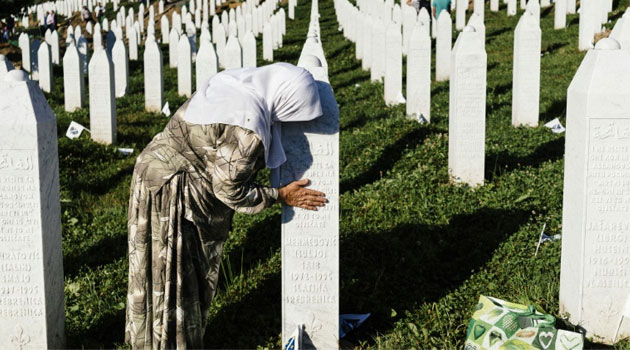
A Bosnian woman mourns at the grave of a relative at the Potocari Memorial Centre near Srebrenica, on July 11, 2015 © AFP
SREBRENICA, Bosnia-Hercegovina, Jul 11 – Tens of thousands of people gathered in Srebrenica on Saturday to commemorate the 20th anniversary of the massacre of thousands of Muslims in the worst mass killing in Europe since World War II.
Some 50,000 people, including dignitaries from across Bosnia and abroad, were expected for the ceremonies as the Balkan nation observed a day of mourning.
The remains of 136 newly-identified victims were to be laid to rest alongside more than 6,000 others already buried at a memorial centre just outside the eastern Bosnian town.
Bill Clinton, who was the US president at the time, and Prime Minister Aleksandar Vucic of Serbia, whose country backed Bosnian Serbs during and after the 1990s war, were among those attending.
Shortly before arriving to Srebrenica Vucic condemned the “monstrous crime.”
“Serbia clearly and unambiguously condemns this horrible crime and is disgusted with all those who took part in it and will continue to bring them to justice,” he said in a public letter.
Serbian and Bosnian Serb politicians have long denied the extent of the killing, although two international tribunals have described the bloodshed as genocide.
Around 8,000 Muslim men and boys were murdered by Bosnian Serb forces after they captured Srebrenica in July 1995 near the end of Bosnia’s inter-ethnic war.
Srebrenica was then supposedly a UN-protected “safe haven” but the Bosnian Serb forces led by Ratko Mladic brushed aside the lightly armed Dutch UN peacekeepers.
The slaughter was followed a few months later by the Dayton peace deal, brokered by the Clinton administration, which ended the 1992-1995 conflict which cost the lives of an estimated 100,000 people.
‘I still cry’
In most cases only body parts of the Srebrenica victims were found, as their bones were moved from mass graves to so-called “secondary” graves in a bid to hide the scale of the atrocity.
Begajeta Salihovic came to bury her father, whose remains were found in two such sites.
“His skeleton is still not complete but we decided to bury him since we want to give him a trace,” said Salihovic, 51, whose brother was also killed in the massacre. Her two other brothers were killed at the start of the 1992-1995 war, but their remains were never found.
Two decades ago Kadira Salkic lost her three sons and husband in the ill-fated town.
“Only God knows how I manage to continue to live … I still cry,” the 75-year-old whispered.
“I have a feeling that I do not see clearly due to tears ever since they disappeared. But there is nothing I can do. Even if I would die it would not make them come back.”
– Genocide dispute –
Although the atrocity occurred 20 years ago, debate continues to rage over its description as genocide.
In 2005, then-Serbian President Boris Tadic attended ceremonies marking the massacre’s 10th anniversary, becoming the first leader from his country to visit the site.
Then in 2010, the Serbian parliament condemned the massacre, and three years later Serbian President Tomislav Nikolic made a personal apology.
But all of Serbia’s leaders, including Vucic, a former ultranationalist-turned-pro-European, have persistently refused to acknowledge the massacre as genocide.
Earlier this week Western powers clashed with Russia on the topic when Moscow — after lobbying by Serbia and Bosnian Serbs — vetoed a draft UN resolution submitted by Britain which called for the Security Council to recognise the Srebrenica mass killing as genocide.
Along with Serbian President Nikolic, Bosnian Serb leader Milorad Dodik welcomed the Russian veto.
He thanked Moscow for “preventing the adoption of a resolution that would have complicated the situation and deepened divisions within Bosnia”.
Two decades on, Bosnia is still frozen in the ethnic divisions that fuelled its civil war, and lags behind its Balkan neighbours in its bid to join the European Union (EU).
After much arm-twisting by the international community, Bosnia emerged from the bloody conflict as a federal state but its leaders have failed to reconcile its communities.
The country consists of two semi-autonomous entities — the Muslim-Croat Federation and the ethnic Serbs’ Republika Srpska. Srebrenica has remained in the Serb-run half.









































